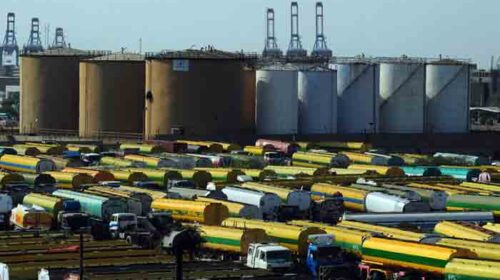Many oil vessels are anchored at the sea awaiting berth, in some cases for days and weeks, at the oil jetty, FOTCO (Fauji Oil Terminal & Distribution Company Limited), which was dragging its feet on investing in expanding its capacity accordingly.
“The government should address the congestion of vessels carrying petroleum products at Port Qasim, while the relevant ministry must form a special committee to devise and implement urgent strategy in this regard,” said Oil Companies Advisory Council (OCAC) in a letter to the Ministry of Energy.
“The claims of FOTCO that it can handle volumes of up to 12 million tonnes per annum and has the potential capacity of 14 million tonnes per annum, which is an overstatement.”
According to FOTCO, their designed capacity is 9 million tonnes per annum, while its actual “achievable” capacity is much lower due to various factors.
In 2016-17, FOTCO handled approximately 153 vessels and a volume of 8.6 million tonnes only, which included 5.1 million tonnes furnace oil volumes.
As a matter of fact, FOTCO has handled approximately 6.6 million tonnes from July 2021 till April 2022.
“We believe that 3-4 percent annual growth for Mogas and HSD imports is an underestimated figure, espesially after the commissioning of White Oil Pipeline (WOP) and thus majority of Mogas imports (80 percent), almost 100 percent HSD and furnace oil imports need to be handled at FOTCO,” the OCAC said.
“Thus 8.5 million tons per annum import requirement at FOTCO is an underestimated figure because currently quite a few cargoes are being shifted to KPT owing to port congestion.”
In fact, FOTCO’s handling capacity due to port constraints may not be beyond 8.5 million tonnes per annum, which is a deterrent to the success of 132 million WOP multigrade strategic project and ultimately to the country’s supply chain, the oil sector’s representative body said. Oil body pointed out that main factors affecting FOTCO’s efficiency were unavailability of night navigation and channel issues due to which an average of at least 12 hours’ time is wasted from completion of vessel discharge till berthing of the next vessel.
“This amounts to a loss of around 7 to 8 days per month and if these issues are resolved, around 5 more vessels may be berthed each month at FOTCO, enhancing the capacity from 15 to 20 vessels.”
It said in the peak period of April 2022, FOTCO was able to berth only 16 cargoes against the planned vessels of 24, out of which two vessels were shifted to KPT owing to severe port congestion, while the remaining were spilled over to the next month.
Oil body proposed the government needed to ensure: construction of separate/dedicated tanker discharge lines, each for Mogas and HSD cargoes, availability of night navigation at FOTCO/PQA for empty and loaded vessels, product sampling at outer anchorage during monsoon season and shifting of condensate/naptha vessels for exports from PQA/FOTCO to Keamari/KPT in line with energy ministry directives as well as arrangement of alternative navigation channel to facilitate entry/ exit of the increasing number of vessels, conversion of FOTCO into a purely finished product/ fuels jetty and expedited implementation of channel widening plan of PQA for LNG vessels and construction of additional petroleum jetty at Port Qasim
The OCAC also urged the government to speed up pipeline projects relating to connectivity of KPT and PQA for flexibility of operations and security of supply chain of petroleum products.
“Pakistan is an energy-deficit country and its requirements are fulfilled by importing crude oil, petrol, HSD and Fuel Oil from abroad.”
Despite an increase in port charges by the government, the FOTCO is reluctant to make any investment in infrastructure to improve and facilitate berthing of vessels and ensure quality of product, the oil sector said.







